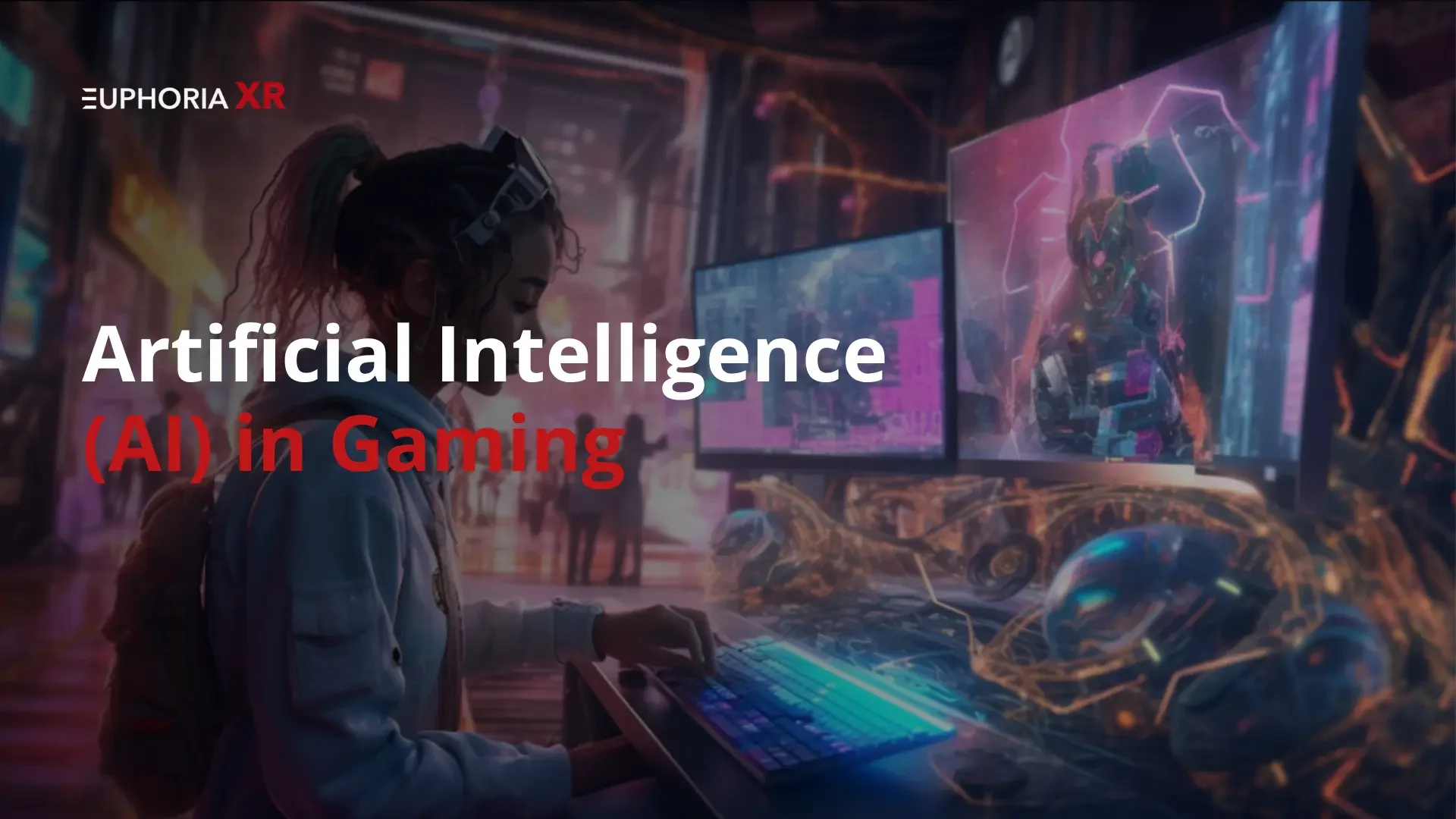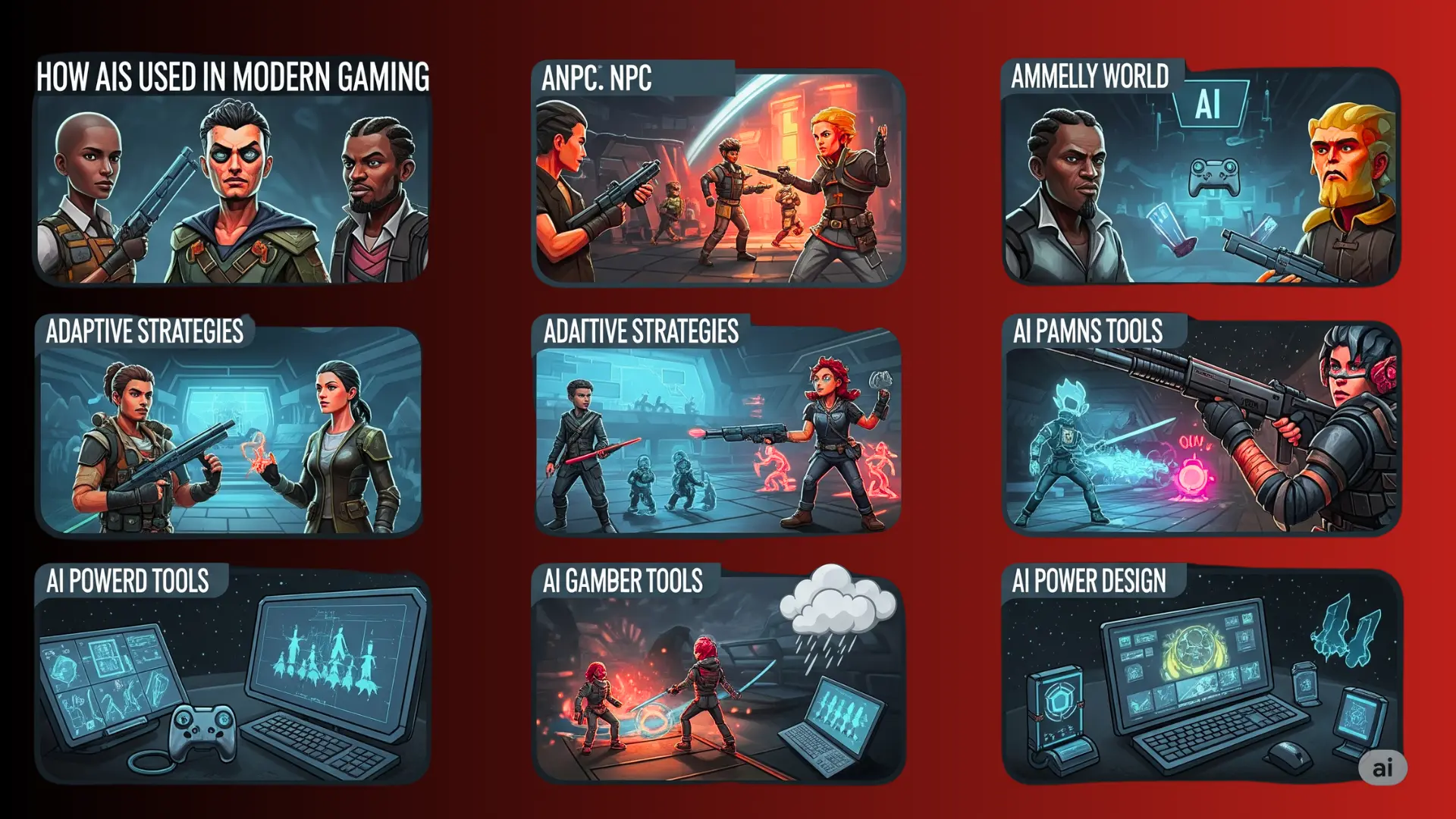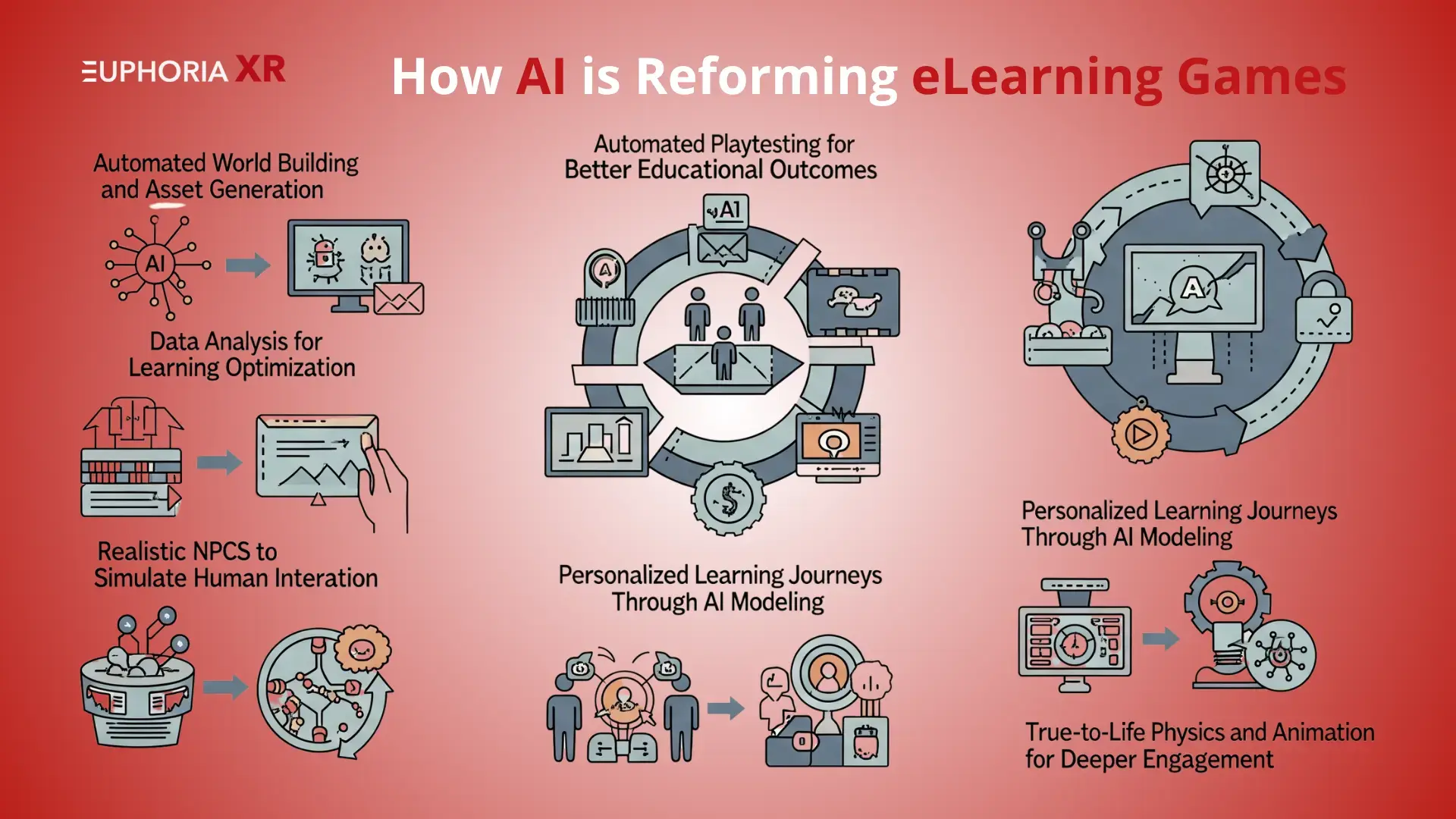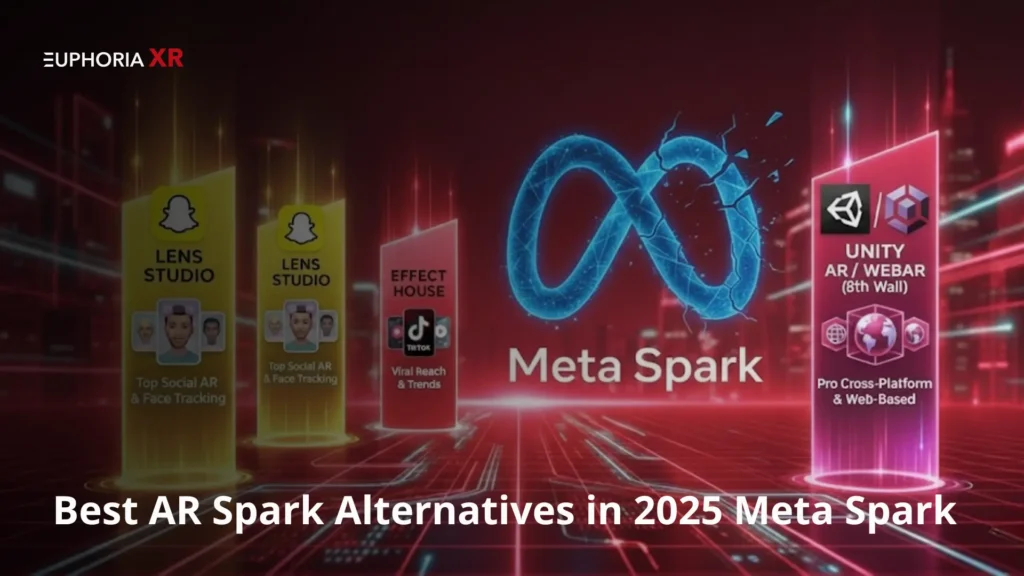Have you ever wondered why the games that you play in the recent past give you the impression that these characters are almost real, they think by their own accord, this world transforms around you, and you never feel the same thing twice. Now, that is not merely a happenstance.
The invisible force has been Artificial Intelligence (AI).
This is where it becomes interesting: Most of the time, gamers remain oblivious to the methods by which AI has altered the game scenery of their games. It is not so much about smart foes or striking graphics with AI. AI is one of the factors that affects the way the stories are being told, the way the challenges are being created, and the way the games are going to reach out to you and touch you as a person.
And to tell the truth, we are touching only the skin of the matter here.
This article looks into how Artificial Intelligence in gaming is bringing to life, even smarter worlds, more realistic characters, and continually emerging playing mechanics that would have been an impossible notion a few years back. You will read this article, and at the end, you will be looking at your favorite games differently.
Searching for a reliable AI partner? Euphoria XR blends proven expertise with real-world results.
How AI is Used in Modern Gaming
Smart Opponents: NPC Behavior and Decision-Making
In the previous games, the enemies present in video games acted in simple patterns. The result of the AI technology applied to modern video games is the analytical capacity of the computer-controlled characters (NPCs), followed by behavioral adaptation, leading to a response at the level of a player.
The Last of Us Part II presents intelligent enemy behavior in that they work collectively as a team when enemies call on more backup in defensive actions and switch course of action when a player tricks him or her. It makes every encounter unique, thereby making the fun more exciting.
According to the research, Newzoo (2024) discovered that about 65 percent of players feel more immersed due to their smart AI opponents.
Ready to implement AI that works for your business? Partner with Euphoria XR for innovative, results-driven AI Development & Consulting
Enhancing Graphics with AI Upscaling and Image Processing
The appearance of characters in the games and their thinking capacity make an essential part of the contribution of AI in the gaming industry. In Deep Learning Super Sampling, the graphical enhancement method DLSS functions at NVIDIA to optimize game graphics with the help of AI-based technology.
The technology enables video games to have detailed images but without a trade-off in computer system performance. NVIDIA artificial intelligence upscaling techniques give users a 50 percent increase in frames per second at any given visual fidelity.
Procedural Content Generation (PCG) for Endless Worlds
Every time playing this game, the surrounding becomes another one as well. Procedural Content Generation (PCG) turns artificial intelligence into a source of infinite content for level maps and stories. The process of the automated system does not involve the human designer in creating new environments.
PCG acts as the spine that creates massive random worlds that are seen in Minecraft and No Man’s Sky.
Player-Experience Modeling (PEM) for Personalized Gameplay
Each gamer has a different style of playing. Various players chose either intense, action-packed play or free time to do things on their own.
The technology of Player-Experience Modeling (PEM) allows AI to learn patterns of gameplay and subsequently alter the game experience to fit the needs of each specific player.
The game system will also show you easier puzzles and harder enemies once it realizes that you have trouble with brain games, but are already good at fighting.
Real-Time Data Mining and Analytics for Adaptive Games
The games in this new age not only allow personal gameplay but also provide lessons on a world database that consists of millions of players.
The trend is also known or identified with the help of AI systems that analyze real-time data that provides information about player behavior and issues of the system with the help of analytics. The developers use this information to develop new versions where they are sure of fixing bugs and adding new features that players find interesting.
Real-time analytics enables Epic Games to update the features of the Fortnite gameplay and weapons, as well as events, due on the actions of the players.
Cheat Detection and Fair Multiplayer Environments
Multiplayer gaming cannot withstand cheating.
Thankfully, AI is on guard.
Millions of games are checked daily with the help of Valve AI-based systems such as VACNet. The two assist in detecting suspicious patterns faster than any human being can. With the help of AI, hacking and cheating in video games are now hard, and online gaming is more pleasant and fair.
AI Virtual Assistants Inside Games
It is not the era the artificial intelligence was functioning secretly during the games, as at present, it actively lives in the gaming systems. Some games combine virtual assistant systems that utilize AI, which provide strategic tips to users and also gives them the ability to manage games.
An AI-powered virtual guide will also give you a helping hand only when you need it, to give you some support and allow you to explore the world on your own.
Different Types of AI Used in Games
Rule-Based AI
The simplest version of artificial intelligence is the simplest form of artificial intelligence implementation. It implements an accurate package of rules to act. Conventional video games possess systems of enemies that patrol the fixed areas in time. These primitive behaviors work well as long as their performances are directed by rules-based AI systems, yet their repetitions can be easily predicted.
Finite State Machines
The main work of a finite-state machine is to determine when to make the transition from one behaviour of NPCs to another, depending on what is happening to it.
For example:
In case nothing was spotted → Patrol.
“In the sight of the enemy → strike.”
And as a response: “When in ill health, necessarily: run away.”
FSMs enable the characters to be smarter without intricacies.
Behavior Trees
Behavior Trees are the best techniques that are used by teams to order AI behaviors. Critical decisions are made easy by the system in breaking them down into several logical applications. In a normal case, an NPC will perform more competently by getting and hiding before it has gotten a location to strike when it is acceptable.
The activities of Halo and the Battlefield gameplay rely on the behavior tree to have an authentic tactical operational approach to enemies.
Pathfinding AI
Pathfinding AI allows intelligent decision-making capability for characters to navigate their environment. When a person chooses any point on the map, the pathfinding AI system will be able to calculate or find the safest path of navigation through the location without touching the walls and traps.
A* (A-star) algorithm is a well-known example of an implementation of the smart navigation features in many games.
Machine Learning and Reinforcement Learning
Artificial intelligence games have been designed to play by themselves using machine learning and reinforcement learning techniques in order to acquire skills through learning information about their interactions with the game environment. It is during the experiment that AI finds the best way of doing something, and once it finds the best way, it uses this to arrive at what it deems as optimum strategies.
OpenAI created Five, which allowed their artificial intelligence team to acquire skills to play Dota 2 well enough to beat human masters.
Transform your business with results-focused AI consulting by EuphoriaXR — where innovation meets measurable impact.
Groundbreaking Innovations in AI Gaming
AI for Realistic and Emotional NPCs
The personalities of the video game characters had fewer complexities until a few years ago. Artificial Intelligence has created a technology that has managed to create Non-Player Characters that are slowly becoming as real to human behavior as possible.
The employment of the emotional AI technology enables NPCs to showcase different emotions, such as fear, besides anger and sadness, and joy, depending on the context at the time. The characters employ the use of their memory capacities to remember earlier interactions with the player in order to deliver various accounts of adjusted reactions depending on veritable relationships.
The characters of the Red Dead Redemption 2 present as part of the gameplay influence their reaction according to your relationship with them, whether you helped or hurt another person.
Indeed, 72 percent of respondents in a Unity Technologies survey for 2023 report that a sense of immersion is heightened when it seems that NPCs are responding emotionally..
Proactive Game Design Driven by AI Insights
The distinction between their way of interaction and AI players is one of the components of artificial intelligence systems that enable developers to create a better game.
AI tools analyse the behaviour of gamers together with the patterns of their choices to suggest new gameplay abilities and predict the popularity of the field in the future, and recommend the replacement of the storyline in the game development process.
The application of artificial intelligence in the development of games leads to improved quality releases immediately after release.
Procedural Generation of Levels, Quests, and Worlds
The strategic developmental progression of PCG has gone through another level than what was mentioned earlier. The new AI technology can no longer present random results as it generates spaces that have a certain sense of being anthropogenic.
The enhanced AI of No Man’s Sky creates plans, animals, and weather patterns that are different in every space exploration.
The method reminds the previous point in that AI can help in the creation of procedural content, decreasing the development cost and maximizing discovery.
Advanced Game Analytics for Player Behavior Understanding
Developers in the present day leverage artificial intelligence-based big data to learn both what pleases players and what angers them.
When AI tracks millions of gameplay data it reveals:
- Identify the levels where players quit
- Spot confusing parts of tutorials
- AI evaluates popular game attributes
Ubisoft, alongside other companies, employs these insights for designing upgraded gameplay elements that attract their player base.
AI-Based Difficulty Adjustment for Personalized Challenges
Each gamer prefers their level of challenge since some seek calm gameplay, but many favor demanding difficulties. AI technology enables games to modify the challenge level automatically according to your present success rate.
Utilizing artificial intelligence, Resident Evil 4 automatically modifies the resistance levels of adversaries when you demonstrate success in the game.
Such systems provide challenging gameplay that does not become frustrating or tedious.
AI-Assisted Testing for Faster, Smoother Game Releases
Every game requires extensive pre-release testing that detects problems before its launch. AI bots use their efficiency to test games much quicker than living beings by exploring complete areas that activate each available scenario.
Fact: Research finds AI playtesting support leads to a speedup in testing times by 60% as reported by GDC (2024).
Such advancements result in released products with fewer breakdowns, which produce satisfied customers.
Emerging Trends Shaping the Future of AI in Gaming
Generative AI for Content Creation
Generative AI is witnessing great momentum in the field of gaming.
Developers can use it to create in an automated fashion:
3D models
Soundtracks
Dialogs
Entire quests
Instead of months designing tiny details, a couple of hours spent with AI help can build worlds, characters, and stories.
Examples: Runway ML and NVIDIA Canvas allow artists to quickly turn simple sketches into game-ready environments with the help of AI.
Cloud-Based AI Gaming
Cloud gaming already allows players to play games without having heavyweight hardware to run them. AI is making cloud gaming even smarter and faster.
AI optimizes:
Game streaming speeds
Real-time generation of AI opponents
Personalized gaming sessions that are stored in the cloud
Platforms like Google Stadia and NVIDIA GeForce NOW are test-driving improvements powered by AI in cloud gaming, aimed at reducing lag and enhancing gameplay quality.
Blockchain, NFTs, and AI Integration
Gaming economies thus evolve.
With AI integrated with blockchain tech and NFTs, developers could build:
More intelligent in-game economies
Fairer player-owned assets
Unique character developments based on player actions
Example: Axie Infinity is an example of blockchain technology, with future versions investigating the territory of AI consciousness-creatures that learn and grow with time.
AI in AR, VR, and the Metaverse
The future for immersive gaming lies with AR, VR, and the Metaverse.
AI helps to make such experiences more:
Responsive
Life-like
Personal
Imagine virtual worlds where NPCs remember your choices across games, or VR cities that evolve based on the way millions of players go through them.
Fun fact: The VR and AR industries are projected to grow to $1.5 trillion by 2030, according to PwC, with most being driven by AI innovations.
How AI is Reforming eLearning Games
Automated World Building and Asset Generation
Through automation, developers gain access to both world development capabilities and asset generation systems. Artificial Intelligence enables faster and less complex creation of complete learning environments.
AI enables developers to manufacture automatic landscape design while simultaneously building buildings and characters instead of manual task completion. Educators can produce excellent educational content instead of spending multiple months on environment creation through this time-saving asset generation method.
Through ML-Agents from Unity, developers can now rapidly generate dynamic educational worlds that retain authenticity.
Data Analysis for Learning Optimization
AI technology demonstrates its strength in eLearning games development through its capacity to analyze learning data. The patterns within student gameplay provide AI tools with data to detect challenging level points and simple lesson sections, along with uninteresting learning moments. Game developers benefit from these data points, which let them update their games to maintain student engagement through effective learning experiences.
Automated Playtesting for Better Educational Outcomes
Testing occurs multiple times on educational games before they become accessible to students. Several programs powered by AI technology conduct virtual playtests that duplicate millions of player interactions.
Automated playtesting enables developers to identify program weaknesses and confusing areas as well as detect bugs more efficiently than conventional testing techniques. Education games benefit from rapid testing that results in lower launch faults, which enables students to experience more consistent learning from day one.
Realistic NPCs to Simulate Human Interaction
The practice of essential skills, such as leadership as well as communication, and empathy, occurs within numerous educational gaming experiences. Through AI, developers generate realistic Non-Player Characters (NPCs) that can display real emotions during dynamic interactions with game user choices. Students benefit from realistic educational experiences due through which they can practice essential skills within a protected environment.
Personalized Learning Journeys Through AI Modeling
Every student learns differently modeling enables eLearning games to modify content based on individual player abilities and weaknesses.
Corrected Reading difficulties enable the system to provide different learning tasks with adjustable pacing, together with customized feedback. Each person benefits from personalized education that enables higher effectiveness.
True-to-Life Physics and Animations for Deeper Engagement
Educational games become much more interactive when they employ realistic characters and responses. Artificial Intelligence (AI) runs physics engines that duplicate the natural motion and collision sequences, similarly to how physical objects behave in reality.
True-to-life animated visuals support student learning of complex concepts by providing practical experience through memorable visuals that represent realistic phenomena.
Ethical Challenges and Considerations of AI in Gaming
Data Privacy
AI-enriched games collect comprehensive data about the players, not only their choices, habits, but even their emotions! Such data needs to be secured. The developers must ensure that the privacy of personal data is not fully leaked or shared without consent and keep it under security from hackers or misuse. Perhaps when there is transparency about what is collected and why, it creates trust between the players and the creators.
Game Addiction
In a way, making Joan Games very fun and personal, it can also be a reason for getting addicted to games. A game continues to change to keep your interest alive, and then the playtime extends even to the unhealthy habit of gaming, especially for children and teenagers. Designers should develop systems that support controlled gaming patterns instead of generating excessive addictions in their users.
Offensive Content
Computer systems equipped with artificial intelligence sometimes produce material that offends people even though they lack the intention to be offensive. When AI analyzes biased data, it may result in unacceptable gaming material, including scenarios and dialogue, if the data is not appropriate for all players. The monitoring process of AI-generated content requires developers to implement human screening protocols for catching undesirable content before it reaches player access.
Balancing Innovation and Responsibility
AI brings much more powerful engines into play for designing better and smarter games. However, that does not justify the course one takes in following through on what is possible.
It is the responsibility of developers to strike a balance between the thrill of exceptional innovation and the responsibility to guard the players’ privacy, as well as make pleasant experiences possible.
Ethical design choices will work towards ensuring that AI enhances gaming and does not damage it.
The Future of AI in Gaming: What’s Next
Hyper-Realistic Games That Adapt in Real Time
Games will transform through player interactions instead of keeping the changes limited to predetermined levels while the world maintains realistic autonomy.
AI is making this possible.
Modern gaming systems will use real-time adaptations that modify enemy battle strategies while modifying gameplay scenarios alongside storyline development through player choices. A unique gameplay experience occurs because every run through the game generates different outcomes.
Personalized Storylines Unique to Each Player
Computer programs function as a force that drives gaming toward stories that adapt specifically to each player. Advanced gaming technology will develop adaptable stories that respond dynamically to how you play and what excites you, as well as your emotional responses throughout the game.
In different versions of the game, the same friend will not necessarily exist. Your adventure will belong to no one but yourself because it evolves according to your total decisions.
Fully Autonomous Worlds and Characters
Game worlds of the future will surpass their existing beauty to become autonomous entities. The characters in games will develop individual purposes and recollections, and unique personae, because developers will no longer need to create their scripts in real-time.
The development of cities alongside natural alliance formation will occur in a way that artificial intelligence directs and guides such processes. Upon returning to a particular town after some time, you will discover fundamental changes just as experienced in the physical world.
New Jobs and Opportunities for Game Designers and AI Engineers
The increasing AI role in gaming develops promising professional choices for game industry workers. Game developers will collaborate with artificial systems to create dynamic virtual landscapes. Programmers dedicated to AI development will produce advanced systems that enable virtual worlds to automatically evolve into superior configurations whenever possible.
Newzoo predicts that the number of jobs related to AI in gaming will expand by 35% by 2024 based on its 2024 statistics.
Final Thoughts: AI’s Gaming Revolution Is Just Beginning
Today, Artificial Intelligence operates beyond being a mere prediction of future gaming since it transforms how we engage with games, their educational aspects, and virtual environments.
AI technologies drive games to achieve enhanced non-player characters and boundless customized gameplay experiences, which generate new possibilities in gaming.
Only the beginning is all we have observed.
Technological progress will make possible new, surprising interactive abilities of artificial intelligence that connect with humans in more ways.
Upcoming gaming experiences will create unprecedented live interactive experiences that exceed all past boundaries of gaming capabilities.
Helpers for players and creators have just launched their first mission together.
Frequently Asked Questions (FAQs)
What is AI in gaming?
AI in gaming refers to intelligent computer systems employed to create realistic characters, adaptive worlds, and tailored experiences. It allows games to respond to players’ actions and decisions in real-time.
How does AI improve video games?
AI improves the game by making characters smarter, graphics better, worlds more dynamic, and experiences more personal. It enables a game to learn about the player and adapt to keep the gameplay exciting and fresh.
Which games use advanced AI today?
Many popular games do have advanced AI. The Last of Us Part II, Shadow of Mordor, Red Dead Redemption 2, and Minecraft are great examples where AI controls enemies, builds worlds, and personalizes player experiences.
What is the future of AI in gaming?
The future of AI in gaming brings to mind real-time adaptive worlds, fully autonomous characters, personalized storytelling, and experiences that almost feel like living another life inside the game.
Are there any ethical concerns with AI in games?
Yes. AI in gaming raises critical concerns such as player data protection, avoidance of game addiction, fair treatment, and the exclusion of offensive or biased content. Developers will really need to focus on balancing opportunities with responsibility to foster a safe and positive gaming environment.

















